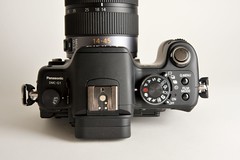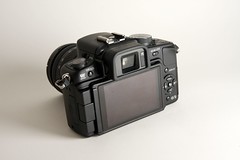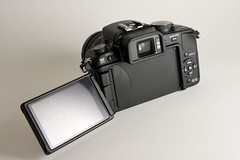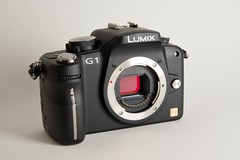Panasonic Lumix G1 review
by Anton Piatek
I recently had the opportunity to review the new Panasonic Lumix G1 Digital SLR. As there are other more detailed reviews out there, I decided to write about my impressions of using it, rather than trying to list statistics about the camera.
The first thing to say about this camera, is that it blurs the term SLR. Strictly speaking it m {.tt-flickr.tt-flickr-Small}ight not be an SLR. SLR (Single Lens Reflex) in lay-mans terms means what you see in the viewfinder is a what the camera will take, which is achieved through the use of mirrors and prisms. The G1 uses no mirrors or prisms, as it is fully digital including the viewfinder (unlike Canon or Nikon DSLRs).
{.tt-flickr.tt-flickr-Small}ight not be an SLR. SLR (Single Lens Reflex) in lay-mans terms means what you see in the viewfinder is a what the camera will take, which is achieved through the use of mirrors and prisms. The G1 uses no mirrors or prisms, as it is fully digital including the viewfinder (unlike Canon or Nikon DSLRs).
This is exactly what a compact digital camera uses for the screen on the back, often referred to as “live mode” on DSLR models.
Without mirrors you might say it is not an SLR, however you still see what is coming through the lens and it shows what will be recorded when you hit the shutter button.
I am sure a lot of photographers will have reservations about whether this camera is really a SLR or not, but it the lack of mirrors doesn’t change what it can do. It does use different metering and focusing systems, as the ones used in a normal SLR or DSLR cannot be used as the image is always being processed by the sensor. This gives the adva {.tt-flickr.tt-flickr-Small}ntage that the live mode behaves exactly like on a compact – focusing works as you would expect, unlike the live mode on the Canon 40D.
{.tt-flickr.tt-flickr-Small}ntage that the live mode behaves exactly like on a compact – focusing works as you would expect, unlike the live mode on the Canon 40D.
This camera is a truly small DSLR – The body is much smaller than even the small Canon and Nikon DSLRs, and the lenses are based on a new Olympus format called micro four thirds. This new format is to four-thirds format lenses, as EF-S is to EF lenses in the Canon range. In short, the lens sits much closer to the sensor because it is designed for digital cameras, which allow the lens to sit deeper into the camera body.
The G1 uses contrast-detection focusing, which is the same as the new Canon 50D. As well as that it has live-mode face detection focusing, like the 50D. Of course, as the viewfinder is digital, you see exactly what you do on the screen on the back. The contrast focusing feels a tiny bit slower than the normal focusing on my Canon 40D, however it is only just noticeable.
As you can see in the photos, this camera has a flip out screen. The first thing to say is that the screen is HUGE. It also performs wonderfully in full sunlight, which is great. Being able to flip out the screen i {.tt-flickr.tt-flickr-Small}s something I really like in a camera, and if the lenses were compatible with my Canon range, I would seriously be considering Panasonic as an upgrade…
{.tt-flickr.tt-flickr-Small}s something I really like in a camera, and if the lenses were compatible with my Canon range, I would seriously be considering Panasonic as an upgrade…
The screen actually changes the brightness depending on the light coming through the lens – so if you walk into a dark room, the power output of the screen drops to save power, which is a clever touch.
The screen also turns off when you put the viewfinder to your eye (and the viewfinder actually turns off when the screen turns on again)
Unfortunately I don’t have any screenshots of using the camera, but the software is rather interesting. It has all the normal things you would expect, and I guessed most of it without looking at the manual (which it turns didn’t come with English in my trial kit, so wouldn’t have helped). The camera has several focusing modes, much like the Lumix range of compacts, including a mode that tracks an object in the frame – you select a point in the frame, and it keeps the focus on it as you move the camera around. It works reasonably well, and is rather clever, though I can’t see myself using it.
The information {.tt-flickr.tt-flickr-Small} mode of the back screen shows all your camera settings, including a nice wheel-style chart to show your exposure compensation and bracketing, which is nice. Speaking of bracketing, the camera offers several choices of bracketing presets. Up to 7 bracketed exposures, if i recall correctly, however you cannot choose the spread of exposures yourself – you have to use the presets. It is a shame that you can’t choose this, as most people will want 3 frames with the largest difference between them for doing HDR photography, and there is no preset for this.
{.tt-flickr.tt-flickr-Small} mode of the back screen shows all your camera settings, including a nice wheel-style chart to show your exposure compensation and bracketing, which is nice. Speaking of bracketing, the camera offers several choices of bracketing presets. Up to 7 bracketed exposures, if i recall correctly, however you cannot choose the spread of exposures yourself – you have to use the presets. It is a shame that you can’t choose this, as most people will want 3 frames with the largest difference between them for doing HDR photography, and there is no preset for this.
The lenses I played with were a 14-45, and 45-200. Both were entry level as far as the aperture goes, however both were optically stabilised and did a good job of it. The conversion factor for these lenses is about 2x. This means the 200mm lens on this camera, is about the same as a 400mm lens on a full frame 35mm camera.
These lenses offer really nice coverage – the kit lens is the 14-45 which is a good starting lens {.tt-flickr.tt-flickr-Small}. The 45-200mm lens is a rather impressive zoom lens, especially given it’s size and the fact it is stabilised.
{.tt-flickr.tt-flickr-Small}. The 45-200mm lens is a rather impressive zoom lens, especially given it’s size and the fact it is stabilised.
To be perfectly honest about this camera – I think it has a lot over the bottom-end Canon and Nikons. The full live mode is fantastic, and perfect for someone new to SLR’s as you can simply put it on auto and use it like any old compact. The electronic viewfinder is a little odd at first, at least for a long-time SLR user, but after 10 minutes I forgot it was electronic at all. It is nice that all the info you can get on the screen, you get in the viewfinder, including a live histogram if you want it.
The flip out screen make it far more creative, as shooting from ground level with a normal SLR means lying in the mud.. The creative shooting modes (i.e. portrait, landscape) have a choice of styles, and the custom style tells you what y {.tt-flickr.tt-flickr-Small}ou can change to make the photo different. For example, in portrait mode it allows you to change the aperture, but it shows a slider for background blur as that is really what you are trying to achieve. This, along with styles like black and white being live even in the viewfinder and the fact that you can adjust the saturation and contrast live before the photo, camera has an edge for new users that want to plat with a camera, but haven’t learnt all the SLR tricks and lingo.
{.tt-flickr.tt-flickr-Small}ou can change to make the photo different. For example, in portrait mode it allows you to change the aperture, but it shows a slider for background blur as that is really what you are trying to achieve. This, along with styles like black and white being live even in the viewfinder and the fact that you can adjust the saturation and contrast live before the photo, camera has an edge for new users that want to plat with a camera, but haven’t learnt all the SLR tricks and lingo.
The only thing that stops it competing with the likes of the 40D semi-professional cameras is the max 3fps continuous shooting and range of lenses and flashes. Raw output is already available for those that want it.
I didn’t get the chance to use the camera as much as I would have liked, but here are some sample images (sorry I can’t give full-res copies)
 {.tt-flickr.tt-flickr-Square}
{.tt-flickr.tt-flickr-Square}  {.tt-flickr.tt-flickr-Square}
{.tt-flickr.tt-flickr-Square}  {.tt-flickr.tt-flickr-Square}
{.tt-flickr.tt-flickr-Square}  {.tt-flickr.tt-flickr-Square}
{.tt-flickr.tt-flickr-Square}  {.tt-flickr.tt-flickr-Square}
{.tt-flickr.tt-flickr-Square}  {.tt-flickr.tt-flickr-Square}
{.tt-flickr.tt-flickr-Square}
 {.tt-flickr.tt-flickr-Square}
{.tt-flickr.tt-flickr-Square}  {.tt-flickr.tt-flickr-Square}
{.tt-flickr.tt-flickr-Square}  {.tt-flickr.tt-flickr-Square}
{.tt-flickr.tt-flickr-Square}  {.tt-flickr.tt-flickr-Square}
{.tt-flickr.tt-flickr-Square}  {.tt-flickr.tt-flickr-Square}
{.tt-flickr.tt-flickr-Square}  {.tt-flickr.tt-flickr-Square}
{.tt-flickr.tt-flickr-Square}
 {.tt-flickr.tt-flickr-Square}
{.tt-flickr.tt-flickr-Square}  {.tt-flickr.tt-flickr-Square}
{.tt-flickr.tt-flickr-Square}  {.tt-flickr.tt-flickr-Square}
{.tt-flickr.tt-flickr-Square}  {.tt-flickr.tt-flickr-Square}
{.tt-flickr.tt-flickr-Square}  {.tt-flickr.tt-flickr-Square}
{.tt-flickr.tt-flickr-Square}  {.tt-flickr.tt-flickr-Square}
{.tt-flickr.tt-flickr-Square}
